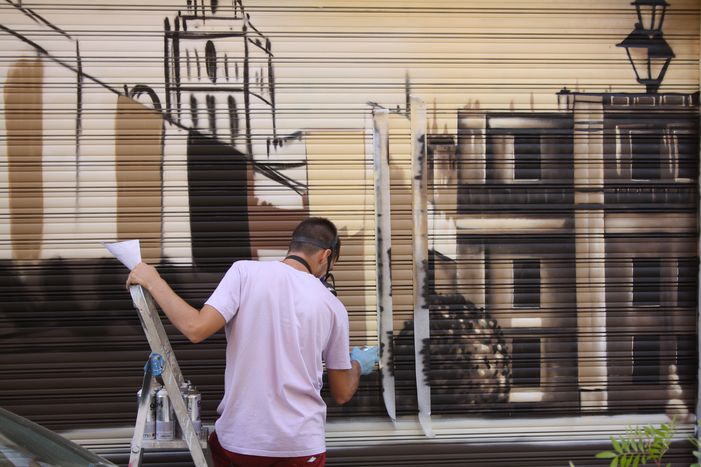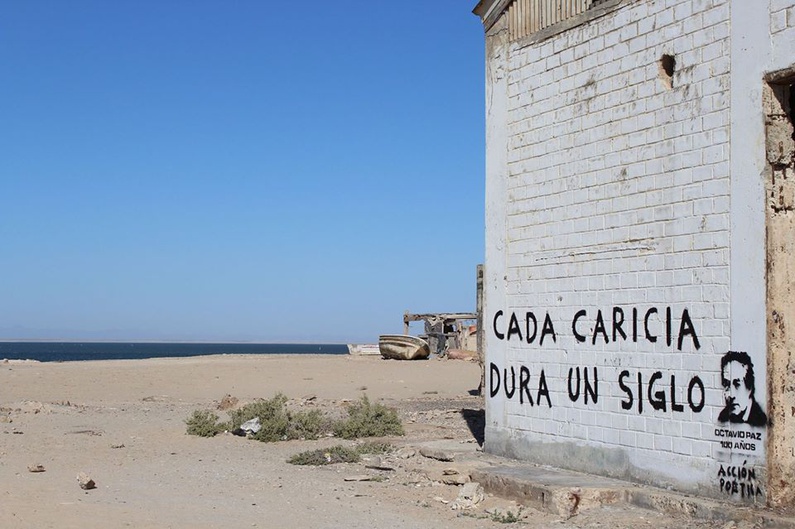
Wandering Poets: Poetry on the Walls
Published on
Translation by:
 Jennifer-Anne Dove
Jennifer-Anne Dove
Music, dance, painting... How about we talk about poetry? Not traditional poetry, but a new form of literary expression. Talking about wandering poets, poets that belong Street Art of the 90s. urban graffiti as a kind of poetry.
We usually use the word wandering to talk about singers who wander around sharing their music, dancers or dance groups who show off their choreographies to passers-by, in exchange for their goodwill, or painters who display their own art gallery on the pavement . But what happens when we hear that about wandering poets? Can you be a poet between pavements and buildings? ¿Does this break with the traditional blueprint of those who write their verses using paper and pen? Do these poets form of the urban world, known as Street Style or Street Art, that appeared in the 1990? The answer to all of these questions is yes.
Today I want to talk to you about Poetic Action (AP), an urban literary movement that includes a great number of wandering poets who are already travelling around the entire world. It is a movement whose wall-literary phenomenon is about de written on walls and fences that transmit a poetic message with verses expressed on the walls. Its founder is Armando Alanis Pulido who in 1996 started to spread these poetic messages accross walls and slopes in the city of Monterrey (Mexico). Since then, Armando has filled more than 7000 walls with poetry in his home city during these 15 years, and has been recognised on many occasions, like for example when he was awarded the Arts Prize of the Universidad Autónoma de Nuevo León (2005) and the Ubaldo Ramos National Prize of Young Poetry (1998), among others.
The content of its poetry is, principally, thoughts about love and profound optimistic phrases created by its own members, also even at times quoting famous writers such as Octavio Paz or Jaime Sabines. Generally the setting for these poets is a white wall painted with black letters, subsituting the tradition pen and paper. The sentences don't usually contain more than 8 words. Just like they maintain it is a type of micropoetry. At the end of each sentence we can find the signature of Poetic Action -in capital letters on the lower part of the wall - and, sometimes can include the name of the city where it is found.

But Poetic Action doesn't stop here. Currently there are more than 3500 walls written on around the metropolitian area in the state of Nuevo León, and it has arrived in other cities in the same country, such as Mexico City and Guadalajara. At the same time it has extended to other Spanish speaking countries such as Argentina, Chile, Panama and Spain. Furthermore, various wandering poetry groups exist that carry on expanding this urban-literary phenomenon like has happened for example in Chile, that has a group of wandering-poet students, or in Argentina where lots of friends with paintbrushes and tins of black paint cover the walls with poetry, and whose coordinator is Fernando Rios Kissner.
Both groups share a characteristic: before expressing their own poetry, they paint ten walls with verses of Armando Alanis Pulido - a poet who inspires them and founder of AP-, to pay homage to him. And then most important, none of these walls are painted illegally, some much as Armando, like all the AP groups in Perú, Bolivia, Buenos Aires, Murcia, Madrid, Venezuela, Nicaragua and many others, obtain prior permission to create their masterpieces.
Last but not least, AP features several rules, regulations and principles that they must obey to be able to be form part of this massive movement. On one hand, very importantly, they asked that their artists activly carry on the movement and that they give notice and ask for permission to be able to paint the walls. Furthermore, they don't accept money, only donations of paint (black and white), paintbrushes and wall, which are three essential parts of this phenomenon. On the other hand, they choose the phrases according to the wall, the context and the street, and they always give the other the chance to choose their own phrase. Finally, said phrases usually don't contain more than 8 word, to guarantee quick and effective visibility, what they can micropoetry. A piece of information to keep in mind is that, in 2014, Poetic Action arrived in 110 mexican citiesand a total of 26 countries.
Can we talk therefore about wandering poets or simply about poets like Armando, that the only thing they hope to do is show their creations in the way they like the most: free and accessible poetry for all the public?. This ia what the Argentinian spokesman Fernando Rios Kissner declared, agreed upon by Alanis Pulido as coordinator of the Americas South Cone region: "We write poetry read by thousands of people, much more than would go out to by a book of that type of poetry that the big chain shops wouldn't even display".
Maybe it wouldn't be unwise not scandalous to consider this free and original expression as art in its purest form, an art that covers the streets of so many cities and that speaks to the common man without limits. As someone once said, “Art is the expression of the soul that wants to be listened to”, so that is precisely what these urban poets hope to achieve: bare their souls infront of the eyes of the pedestrians in a unique way.

We can't deny what is obvious, the phenomenon of poetic graffiti has taken gigantic steps thanks to, in part, social networks like Facebook, Twitter, Pinterest and Instagram, where every day they post hundreds of photos and inform their readers of the next events where they can participate and contribute to what they call urben poetry. Furthermore, they have filmed a documentary called Raining Poetry, that talks about Armando Alanis and his project Action Poetry, whose original obective was no other than to shed light on the problems of a gloomy city like Monterrey. Just as Alanis Pulido points out “the idea is that poetry is part of the urban landscape”, although it can also consider itself as a project that promotes reading and the revival of values.
AP is also currently working on the project Peace for Mexico that, through coordinators, consistes of visiting 100 cities and painting 100 walls with phrases and/or poems of Octavio Paz. Further more, each billboard will have a black and white image of Octavio and the signature of Poetic Action in capital letters on the bottom part of the wall. Each group, under the responsibilty of a coordinator, publicises photos of their walls under the hashtag #SinPoesíaNoHayCiudad, the characteristic motto of Alanis Pulido.
The weapons of mass creation move forward at an accelerated rhythm and poetry is already in the street, now the question is how long will the rainbow verses last? Are we at the forefront of a new poetic era?
Translated from Poetas callejeros: Versos en los muros


